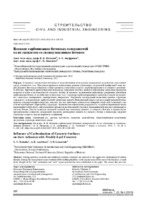Влияние карбонизации бетонных поверхностей на их сцепление со свежеуложенным бетоном

Date
2021Publisher
Another Title
Influence of Carbonization of Concrete Surfaces on their Adhesion with Freshly-Laid Concrete
Bibliographic entry
Молодин, В. В. Влияние карбонизации бетонных поверхностей на их сцепление со свежеуложенным бетоном = Influence of Carbonization of Concrete Surfaces on their Adhesion with Freshly-Laid Concrete / В. В. Молодин, А. Е. Ануфриева, С. Н. Леонович // Наука и техника. – 2021. – № 4. – С. 320-328.
Abstract
В процессе эксплуатации бетонные и железобетонные конструкции подвержены воздействию агрессивной среды углекислого газа. При реконструкции и капитальном ремонте причальных сооружений прибрежной зоны морей Дальнего Востока установлена слабая прочность сцепления «старого» карбонизированного и «нового» ремонтного бетонов. Причиной, препятствующей надежному сцеплению бетонов, является образование непрочных продуктов коррозии в порах и на поверхности «старого» бетона. В процессе исследования выполнены ускоренные испытания карбонизации бетона от воздействия углекислого газа. Структура карбонизированного цементного камня исследована с помощью электронного сканирующего микроскопа. Результаты исследований позволили оценить структуры «здорового» и пораженного карбонизацией цементных камней. Выполненный анализ процесса карбонизации бетона, включая микрофотографии образцов, показал, что под действием углекислоты поверхностный слой толщиной 4 мм и более претерпевает перестройку структуры. Волокнистые образования разрушаются, и карбонизированный объем представляет собой груду слабосвязанных рыхлых новообразований и пленок, перекрывающих входы в капиллярную систему бетона. Они не являются надежной основой для сцепления «нового» и «старого» бетонов и препятствуют проникновению жидкости, содержащей продукты растворения цемента из «нового» бетона в капилляры здоровой структуры «старого» для их надежного соединения.
Abstract in another language
During operation, concrete and reinforced concrete structures are exposed to the aggressive environment of carbon dioxide. During the reconstruction and overhaul of the berthing facilities in the coastal zone of the seas of the Far East, a weak bond strength of the “old” carbonated and “new” repair concrete has been established in the paper. The reason that prevents reliable adhesion of concrete is the formation of fragile corrosion products in the pores and on the surface of “old” concrete. Accelerated tests of concrete carbonization from exposure to carbon dioxide have been carried out in the course of the study. The structure of the carbonized cement stone has been examined using a scanning electron microscope. The research results have made it possible to assess the structure of a “healthy” cement stone and affected by carbonization. The performed analysis of concrete carbonization process, including micrographs of the samples, has shown that under the action of carbon dioxide, the surface layer with a thickness of 4 mm and more undergoes structural restructuring. Fibrous formations are destroyed, and the carbonized volume is a heap of loosely bound loose new formations and films blocking the entrances to the capillary system of concrete. They are not a reliable basis for adhesion of “new” and “old” concrete and prevent the penetration of liquid containing cement dissolution products from “new” concrete into the capillaries of the healthy structure of the “old” concrete for their reliable connection.
View/
Collections
- № 4[11]
